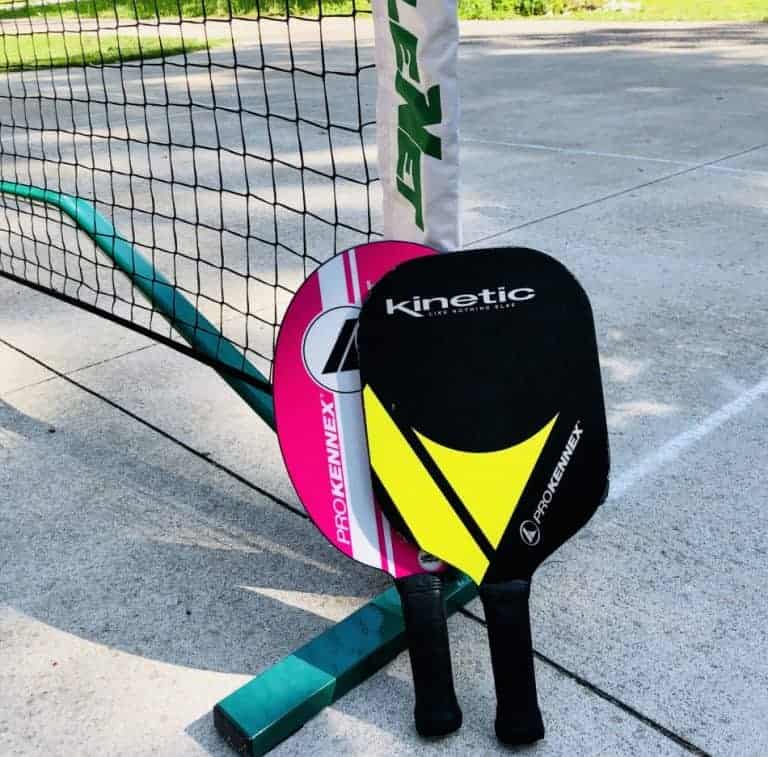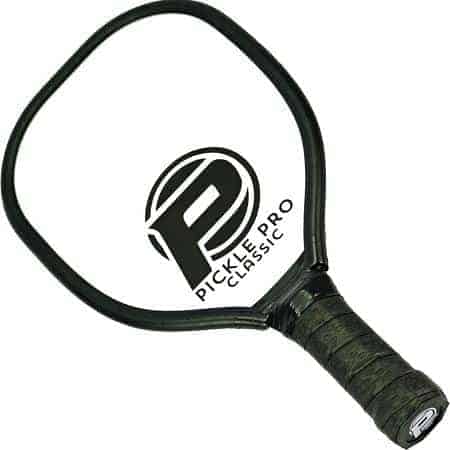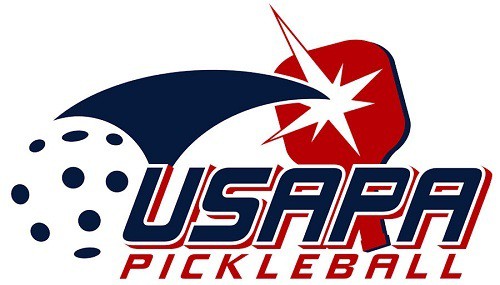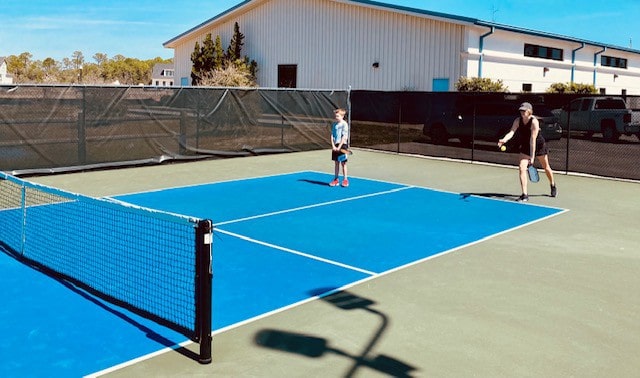Where Did Pickleball Originate And Who Invented It?
Pickleball is one of America’s fastest-growing sports and has become a popular choice at many parks and recreational facilities. With over 2.5 million players across the United States alone, it is becoming a favorite among many different crowds. With so much popularity behind it, where did pickleball originate?
Pickleball originated in 1965 on Bainbridge Island, Washington when three dads, Joel Pritchard, Bill Bell, and Barney McCallum, created pickleball as a means to occupy their families outside. Soon after, pickleball was being played all over Washington and surrounding states.
Keep reading as I share with you where pickleball was invented and how the game grew methodically through the years.
Related: Click here for a friendly beginners guide to the 5 key rules of pickleball.
Where Was Pickleball Invented And How Did It Originate?
The timeline of pickleball’s record breaking growth is a fascinating tale. Believe it or not, the game originated along the south west shore of Bainbridge Island WA on an old badminton court of a summer cottage owned by congressman Joel Pritchard.
From a beat up old badminton court to parks and tennis centers nationwide, the game grew like a weed in the hearts and minds of anyone that Joel Pritchard and his two good friends Barney McCallum and Bill Bell taught the game to.
I’m going to give you a detailed overview of the game’s origins through the years starting in it’s birth year -1965. Hop on the ol’ pickleball time machine and come along.
1965
The year is 1965 and it’s a cloudy, rainy day on “The Rock” as Bainbridge Island is affectionately called. Here, three families, the Pritchards, the Bells and the McCallums were enjoying a family vacation together but all was not well.
Each family’s kids had become bored and crabby so Joel, Barney and Bill told the kids to go play around at the Pritchard’s old, run-down badminton court. The three dads scrounged up a few random badminton rackets, a couple of worn-out ping pong paddles, and a random wiffle ball and told them to whack the ball back and forth over the net.
The net for badminton was way too high for that kind of wiffle ball, so the net was lowered and slowly but surely the seeds of pickleball were being fertilized. After playing the game for an entire weekend, the three men began creating and formalizing the rules so their families could play it again.
It wasn’t long before Barney McCallum created the “M1” and “M2”, the game’s first wooden pickleball paddles made from his bandsaw in his basement. That same classic pickleball paddle shape of the M2 still holds true today.

That’s a testament to his engineering skills.
Related: Click here for my rundown of my all time favorite paddles and the one I’m currently using.
Through the winter of 1965, Joel, Barney and Bill agreed on which kind of wiffle ball would become the official ball of pickleball and began to move the “no-volley zone” line back at 6 inch increments before they found the perfect length at 7 feet.
As winter died down, there was one last rule to finalize. The double bounce rule. The game’s three creators were instrumental in this unique rule that takes the service advantage and actually gives it to the return team.
This is the biggest rule that separates it from tennis.
As Barney McCallum would say, these two rules, the 7 foot no-volley zone rule and the double bounce rule gave the game unprecedented balance. By design, the game evened the playing field. Young, athletic, physically imposing players couldn’t dominate the game.
These two rules evened the playing field and made the game fun and challenging at the same time no matter how skilled or athletic you were. This allowed the game to be played by young and old players.
Helpful Info: Click here for this helpful guide I created for pickleball strategies designed for beginners.
1967
It wasn’t long before official rules got created and more paddles were made out of plywood by hand in the garage of Barney McCallum. The game grew through word of mouth as the families invited their friends to play with them.
Pretty soon everyone wanted Barney to make paddles for them too. It didn’t take long before Barney was being paid to manufacture paddles for friends and families and their friends around Bainbridge Island.
As the game grew more popular with the Prichard’s, Bell’s and McCallum’s group of friends, the game’s wonderfully inclusive social aspect was born.
Even today, the game of pickleball is so unique because of its wonderfully engaging and inviting social component. The Pritchards and McCallums invited everyone they knew to come to play. That same social acceptance and inclusivity can still be felt today on courts across the country.
No other sport in American history has this type of friendly, social acceptance built into its DNA. In 1967, Joel Pritchard’s neighbor Bob O’Brien built the game’s first-ever permanent pickleball court in his backyard. What about the very first court at Joel Pritchard’s house on Bainbridge Island?
While that’s still considered the original “A court” as it’s called, it still had all the classic obstacles of a homemade court made and improvised on someone’s property. Joel’s original court had trees and bushes that would impede players and cause an unfair advantage based on which side you were playing on.
Classic driveway, home court stuff while the game was being perfected.

My Favorite Portable Net: Click here for the one and only portable pickleball net I use for my own driveway pickleball.
But his neighbor Bob’s court was the real deal. All pavement with plenty of room to run and swing with no trees to worry about.
1968
Three years after the game’s accidental creation, Barney McCallum created his own dedicated pickleball court in his backyard. This was technically court #3 and was known as “the McCallum court” by family and friends.
The game was addictive and growing quickly amongst the three families and their friends. But these three courts were only on the island. Once everyone left their summer home and went back to the city, what would they do then?
Little did they know congressman Joel Pritchard and his bandsaw buddy Barney McCallum had plans to take the game off “The Rock” and into the greater Seattle area, at their regular homes and beyond.
In the early 1970s the game jumped from Bainbridge Island to the mainland of Seattle where Barney McCallum began to persuade neighbors to play with him in his hometown of Magnolia Bluff (Seattle) where they would construct portable courts in the neighborhood street.
It wasn’t long before one of Barney’s neighbors, who needed some landscaping work done, decided to forgo traditional landscaping upgrades and instead installed a full fledged concrete pickleball court in his backyard!
The game got another jolt of popularity when Joel Pritchard, who was running for congress at the time, would set up a court at his political fundraisers and encouraged attendees to go a little two on two.
Again, the game was all about bringing people together and having fun! That “inclusive feel” never wavered. Part of that inclusive feel permeated into local schools in the Seattle area.
By the early 70s, Barney and his son began to branch outside of Seattle where they offered and taught the game of pickleball at school programs in the early 70s.
Here the game was demonstrated to local school board administrators where the game was well received. Pretty soon the game was being played at schools all across Washington, Oregon, Idaho, Missouri, California, Texas and into the MidWest in states like Illinois.
At this point the game got the attention of many national news outlets. Press coverage began pouring in. Barney and company began to offer pickleball starter sets and were selling them at a rapid pace!
So much so that an official pickleball entity had to be created to handle the money. So, Barney McCallum created Pickle-ball Inc. Which is still around today.

One of the first non wooden pickleball paddles made
To this day, Pickleball-Inc offers paddles balls and starter sets complete with a net.
1975
By 1975, the sport was featured in an article by the National Observer, dubbed “America’s newest racquet sport.”
Only a year later, in 1976, the first-ever pickleball tournament took place in Tukwila, Washington. Though the first tournament was a huge milestone for the sport, it was mainly played by college tennis players who were relatively new to pickleball.
1980-1989
Throughout the 80s the game saw unprecedented growth and acknowledgement. Racket sport magazines and newspapers began to openly recognize pickleball and include it in the racket sports they covered just like tennis.
The racket sport world had been put on notice.
1990s
From then, the sport grew rapidly, and by 1990, pickleball was played in all 50 states with tournaments everywhere.
By the mid 90s Pickle-ball Inc was making paddles, sets and now their own patented ball.
2000s
The game’s next monumental achievement came in 2001 when pickleball was announced that it would be included, for the first time ever, in the Arizona Senior Olympics where it grew from 100 participants to over 300 in just a few years time.By 2005 the US Pickleball Association was formed, complete with a board of directors where rules and tournaments were officially managed.

For the next 15 years the game saw tremendous growth in every statistical category and claimed the title of “fastest growing sport in the US” for ten consecutive years.
A title it still holds today.
2020 and Beyond
Today, pickleball is an increasingly popular sport with over 8,000 courts available and over 3.3 million players across the United States and abroad. It is a global racket sport.
Hundreds of tournaments across the country allow players to play competitively at different levels, though many people also keep the game casual between friends and community members. Just the way Barney McCallum, Joel Pritchard and Bill Bell would have liked it.
How Did Pickleball Get Its Name?
Pickleball is an unconventional name for any sport let alone a racket sport, and many people wonder where it got its name. Many argue about the origin of the name, though there are two main stories to explain why the game is called pickleball.
Pickleball either got its name after Joel Pritchard’s family dog, Pickles who was known to chase the ball or from the little known phrase “pickle boat” which refers to the game’s origin being a combination or mashup of other racket sports.
The most common question I get after where did pickleball originate is always how did pickleball get its wacky name? Let’s dive into each story.
The first story is that the game was named after the family dog, Pickles. Pickles the dog was known to chase the ball at first giving way to the idea that it was Pickle’s ball which turned into “pickleball”.
Though this story is fun, it may not be entirely accurate, as some sources indicate that Pickles did not join the family until three years after pickleball was invented.
The second story comes from Joan Prichard, Joel’s wife. She says that she began calling the game pickleball after the term “pickle boat,” which is the boat that finishes last in a rowing competition.
The pickle boat is often rowed by a mishmash of athletes from other teams; pickleball was invented using a mishmash of other sports and their components.
No matter where the name came from both stories seem plausible.
Why Is Pickleball So Popular?
Pickleball is so popular because it’s easy to learn for all age groups, and it has a unique way of allowing for competitive play regardless of skill level while bringing people together in the process. It even grew by 21.3% in popularity amid the pandemic.
Though pickleball can be a fast-paced and very athletic game, many also play the game more casually.

Since pickleball does not require the same level of physical impact or technical knowledge as sports such as tennis, it can be played by beginners, children, or even elderly people.
The pickleball community is also known for being very inclusive and welcoming. While some players may compete nationally, pickleball is most often an easygoing and community-centered sport accessible to players of all backgrounds.
What Age Groups Play Pickleball?
Pickleball is accessible to all age groups, ranging from young children to retired adults looking to stay active. The intensity is not as high as other sports, such as tennis, making it easier for people of all ages and fitness levels to enjoy.
According to USA Pickleball, pickleball players are 43.5 years old on average. However, 16.2% of players are younger than 17, and 21.1% are over 65, so there is an extensive range of age groups participating in the sport.
Where Did Pickleball Originate – Conclusion
Pickleball originated in Bainbridge Island, Washington, and has become a popular sport nationally for players of all skill levels and backgrounds.
Though it was created using a patchwork of elements from other sports – including badminton, ping pong, and tennis – it is now a standalone sport that players across the country have come to love.
And it’s becoming the “go-to” method of staying active for a lot of retired people across the country. It’s even preferred over golf in some areas of the country.
Pickleball was born on an island in Washington, home to many summer vacationers. But it quickly went from being a family made sport invented to occupy time, to a full-fledged, standalone, televised racket sport that young people and old people can enjoy…together. And that’s why we love it!
I hope I’ve thoroughly answered the question of where did pickleball originate and given you a glimpse into what it was like to create a sport in your backyard and then have it become a global phenomenon 40 years later.
***This article is written in loving memory of Barney McCallim, Joel Pritchard, and Bill Bell…the game’s founding fathers. Thank you for bringing joy to all of us. You will be missed.

Welcome to TheVolleyLlama.com. My name is Keith, I’m just a lover of all sports that involve a racquet, net and a ball. I played competitive high school varsity tennis, love racquetball and my whole family plays pickleball regularly. I started this website to help give people like you the basics to learn these wonderful games.

